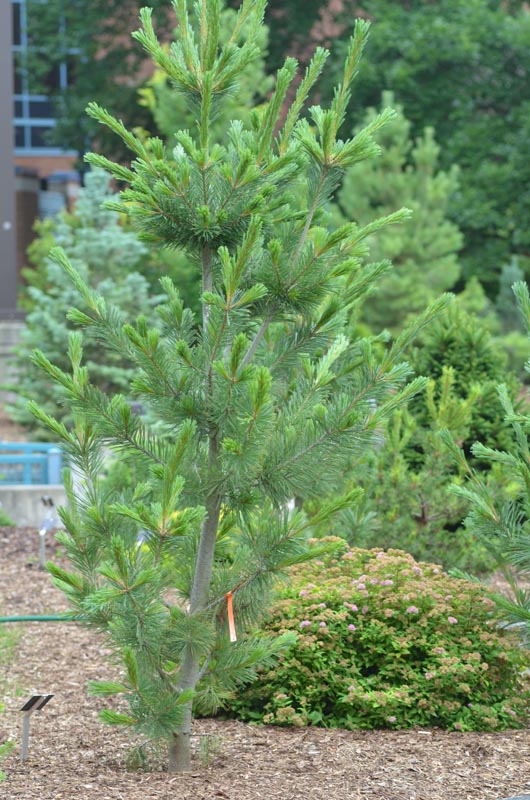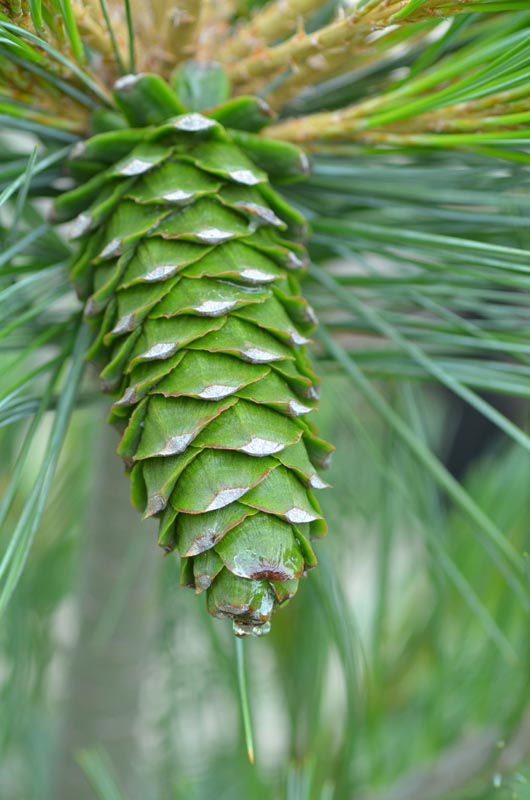
Woody > Pinus > Pinus flexilis > Pinus flexilis 'Vanderwolf's Pyramid'
Pinus flexilis
'Vanderwolf's Pyramid'
Vanderwolf's Pyramid Limber Pine
Origin: Introduced into commerce by Vermeula Nursery of New Jersey in 1972.
Mike's
Opinion


"
Vanderwolf’s Pyramid has a refined pyramidal form with a dense cluster of needles at the end of the branchlets. The interesting outline and branching habits stand out more when planted alone. It is very adaptable and is a low maintenance plant with few problems. Its ornamental value lies in the showy dark green and silvery-blue twisted needles. Vanderwolf’s Pyramid is a very durable tree with flexible branches that can actually be tied into a knot. It was one of only two pines that were not seriously wind burned or injured during the difficult winter of 1976-77 in Chicago.
Michael Pascoe, NDP., ODH., CLT., MSc. (Plant Conservation)
"
| Family |
| Pinaceae |
| Genus |
| Pinus |
| Species |
| flexilis |
| Cultivar |
| 'Vanderwolf's Pyramid' |
| Category |
| Woody |
| Type |
| Tree (evergreen) |
| USDA Hardiness Zone |
| 4 - 7 |
| Canadian Hardiness Zone |
| 2a - 6b |
| RHS Hardiness Zone |
| H5 - H7 |
| Temperature (°C) |
| -34 - (-12) |
| Temperature (°F) |
| -30 - 10 |
| Height |
| 6 - 9 m |
| Spread |
| 3 - 5 m |
Photographs
Description and Growing Information
Flowering Period
| General Description |
| Pinus flexilis 'Vanderwolf’s Pyramid' is a dense, broad, pyramid-shaped evergreen tree. Needles are dark green with silvery blue undersides. Bark is smooth, light grey or grey-green that may turn grey-brown as the tree matures. |
| Landscape |
| Used in landscape plantings such as parks, estates, shopping centres and public areas. Has an interesting silhouette and branching habit with showy silvery-blue dark green foliage which make it a good solitary feature or in small groups as opposed to mass plantings. A handsome specimen with great adaptability; often used for screening, shade or windbreak. |
| Cultivation |
| Very adaptable though it grows best on rocky slopes. Prefers moist, well-drained soil and will grow well in full sun or partial shade. |
| Shape |
| Upright pyramidal form. |
| Growth |
| Slow |
| ID Characteristic |
| Attractive dark green and silvery-blue needles are in fascicles of five and densely crowded at branchlet ends. Flexible, shiny green stems can be tied in a knot. |
| Pests |
| Low maintenance with few problems. White pine blister rust, a bark disease that is usually fatal, is the biggest danger. The earliest symptoms are indistinct chlorotic spots on the needles. |
| Habitat |
| Horticultural origin. |
| Bark/Stem Description |
| Light grey or grey-green when in it's early stages and turns a grey-brown as it matures. Tough, flexible branches are separated by deep fissures. |
| Flower/Leaf Bud Description |
| Sharply pointed with an ovoid shape, about 1.3 cm long. |
| Leaf Description |
| Attractive dark green, silvery-blue needles in fascicles of five, densely crowded at the end of branchlets, sharply pointed, and to about 5 - 7.5 cm long. |
| Fruit Description |
| Short-stalked sub terminal cones, light brown and quite resinous, 7.5 - 15 cm long and 2.5 - 5 cm wide, erect when young and hang pendulously when mature. |
| Colour Description |
| Bark is light grey-green when young, becoming grey-brown as the tree matures. Needles are dark green with a silvery-blue underside. The cone is light brown. |
| Texture Description |
| Medium texture: smooth bark and sharply pointed needles. |
| Notable Specimens |
| The Gardens of Fanshawe College, London, Ontario, Canada. |
References
Richardson, David. Ecology and Biogeography of Pinus. Cambridge, United Kingdom: The Press Syndicate of the University of Cambridge, 1998. Print.
Barney, C. W. Limber pine. In: Eyre, F. H., ed. Forest Cover Types of the United States and Canada. Washington, DC: Society of American Foresters: 1998-99.


